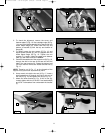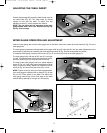
15
Raise or lower the saw blade with the front handwheel (A)
Fig. 41. With the exception of hollow ground blades, raise
the blade 1/8" to 1/4" above the top surface of the
workpiece. Raise hollow ground blades the maximum
amount to provide greater clearance. To raise the saw
blade, loosen the lock knob (B) Fig. 37, and turn the
handwheel (A) clockwise. To lower the saw blade, turn
handwheel (A) counter-clockwise.
You can lock the saw blade at any height by turning the
lock knob (B) Fig. 37 clockwise. Due to the wedge action
of this locking device, only a small amount of force is
required to lock the blade height adjustment securely.
Added force merely puts unnecessary strain on the
locking device. Limit stops for raising or lowering are
permanently built into the mechanism and need no
further adjustment.
The blade tilting mechanism allows the blade to be tilted up to 45° to the right.
To tilt the saw blade to the desired angle, loosen the lock knob (D) Fig. 37, and turn the handwheel (C). A pointer indicates
the angle of tilt on scale (E), which is marked in one-degree increments. To lock the saw blade, tighten the lock knob (D).
IMPORTANT: Always lock the blade in position before starting the saw.
Your saw is supplied with overload protection. If the motor shuts off or fails to start due to overloading (cutting stock
too fast, using a dull blade, using the saw beyond its capacity, etc.) or low voltage, let the motor cool three to five
minutes. The overload will automatically reset itself and the machine can then be started again by pressing the “ON”
button.
IMPORTANT: If the motor continually shuts off due to overloading, contact a qualified electrician.
OPERATION
OPERATIONAL CONTROLS AND ADJUSTMENTS
STARTING AND STOPPING THE MACHINE
1. The on/off switch (A) Fig. 35 is located on the front of the machine. To turn the machine “ON”, depress the “ON”
switch.
2. To turn the machine “OFF”, depress the “OFF” switch.
Make sure that the switch is in the “OFF” position before plugging in the power cord. In the event
of a power failure, move the switch to the “OFF” position. An accidental start-up can cause injury.
Fig. 35
Fig. 36
LOCKING THE SWITCH IN THE “OFF” POSITION
IMPORTANT: When the machine is not in use, the switch should be locked
in the “OFF” position to prevent unauthorized
use,
using a padlock (A) Fig. 36 with a 3/16" diameter shackle.
A
B
A
OVERLOAD PROTECTION
RAISING AND LOWERING THE BLADE
TILTING THE BLADE
A
B
E
A
D
Fig. 37
422-04-651-0064 - 06-20-05.qxd 6/20/05 1:43 PM Page 15


















